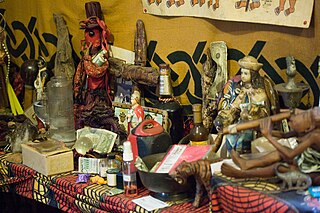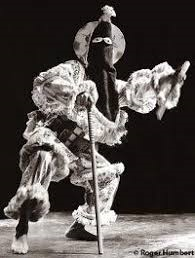Kromanti dance or Kromanti play (capitalised to Kromanti Dance or Kromanti Play [1] ) is a Jamaican Maroon religious ceremony practiced by Jamaican Maroons. It is rooted in traditional African music and religious practices, especially those of the Akan people of Ghana. The name Kromanti (or Coromantee) derives from Kormantin (or Cormantin ) where a historical slave fort in the coast of Ghana was located. Many slaves shipped to Jamaica during the Atlantic Slave trade originated from present–day Ghana in West Africa. [1] [2] [3] [4]
The pure form of Kromanti dance is not one of those contemporary dances of Jamaica, neither is it a Jamaican party or hall dance, but a sacred dance based on the tenets of traditional African religious practices. Although the dance has influenced some aspects of Jamaican culture, and is still practiced today, the religious aspects of the dance are no longer performed as in the past—due to Jamaican Maroons' conversion to Christianity. [5] [1] [2] Despite its modern twist, it is still concerned with solving problems of day-to-day life, such as illnesses resulting from spirit possessions, infidelity, and any other life problems. The Maroons viewed Kromanti dance as a form of metaphorical warfare, a protection on a spiritual level rather than a physical one. [6]
The ritualistic aspects of Kromanti dance involves a "distinctive music and dance styles" which is "centered around possession by ancestral spirits." [7] [1] [2]
Some of the surviving elements derived from African tradition are Country, a music style that uses a drum language like the Dondo, in order to play songs and proverbs; and healing, which is achieved through a rhythmic dance, music, and possession. Like "many other African-derived healing ceremonies, a possessed medium attends to patients, employing song, dance, sacrifice, and herbal remedies." [7] [1] [2]
The Kromanti dance usually begins after nightfall and continues until daybreak. After several hours, the dance losses its recreational momentum and the chief "fete-man" (ritual specialist, similar to an African high priest) becomes possessed. [6]

Junkanoo is a street parade with music, dance, and costumes with origin in many islands across the English speaking Caribbean every Boxing Day and New Year's Day. These cultural parades are predominantly showcased in the Bahamas where the music is also mainstreamed, and competition results are hotly contested. There are also Junkanoo parades in Miami in June and Key West in October, where local black populations have their roots in the Caribbean. In addition to being a culture dance for the Garifuna people, this type of dancing is also performed in The Bahamas on Independence day and other historical holidays. Historically, Junkanoo parades were also found in Southeastern North Carolina. However, the custom became less popular after slavery was abolished. The last known Jonkonnu celebration in the Southern United States was in Wilmington, N.C., in the late 1880s.

African diaspora religions, also described as Afro-American religions, are a number of related beliefs that developed in the Americas in various nations of the Caribbean, Latin America and the Southern United States. They derive from traditional African religions with some influence from other religious traditions, notably Christianity and Islam.

Ghana is a country of 28.21 million people and many native groups, such as:
Obeah, or Obayi, is a series of African diasporic spell-casting and healing traditions found in the former British colonies of the Caribbean. These traditions derive much from traditional West African practices that have undergone cultural creolization. There is much regional variation in the practice of Obeah, which is followed by practitioners called Obeahmen and Obeahwomen.

Queen Nanny, Granny Nanny, or Nanny of the Maroons ONH, was an 18th-century leader of the Jamaican Maroons. She led a community of formerly enslaved Africans called the Windward Maroons. In the early 18th century, under the leadership of Nanny, the Windward Maroons fought a guerrilla war over many years against British authorities in the Colony of Jamaica in what became known as the First Maroon War.
Akan is a Central Tano language and the principal native language of the Akan people of Ghana, spoken over much of the southern half of Ghana. About 80% of Ghana's population can speak Akan, and about 44% of Ghanaians are native speakers. It is also spoken in parts of Côte d'Ivoire.

The Akan people are a kwa group living primarily in present-day Ghana and in parts of Ivory Coast and Togo in West Africa. The Akan language are a group of dialects within the Central Tano branch of the Potou–Tano subfamily of the Niger–Congo family. Subgroups of the Akan people include: the Agona, Akuapem, Akwamu, Akyem, Ashanti, Bono, Fante, Kwahu, Wassa, and Ahanta. The Akan subgroups all have cultural attributes in common; most notably the tracing of matrilineal descent, inheritance of property, and succession to high political office.

The Ewe people are a Gbe-speaking ethnic group. The largest population of Ewe people is in Ghana, and the second largest population is in Togo. They speak the Ewe language which belongs to the Gbe family of languages. They are related to other speakers of Gbe languages such as the Fon, Gen, Phla Phera, Gun, Maxi, and the Aja people of Togo, Benin and southwestern Nigeria.

Abakuá, also sometimes known as Ñañiguismo, is an Afro-Cuban men's initiatory fraternity or secret society, which originated from fraternal associations in the Cross River region of southeastern Nigeria and southwestern Cameroon.
Big Drum is a genre, a musical instrument, and traditional African religion from the Windward Islands. It is a kind of Caribbean music, associated mostly closely with the music of Saint Vincent and the Grenadines, Music of Guadeloupe, Carriacou in Grenada and in the music of Saint Kitts and Nevis.
Jamaican Maroons descend from Africans who freed themselves from slavery on the Colony of Jamaica and established communities of free black people in the island's mountainous interior, primarily in the eastern parishes. Africans who were enslaved during Spanish rule over Jamaica (1493–1655) may have been the first to develop such refugee communities.
Jamaican Maroon language, Maroon Spirit language, Kromanti, Jamaican Maroon Creole or Deep patwa is a ritual language and formerly mother tongue of Jamaican Maroons. It is an English-based creole with a strong Akan component, specifically from the Fante dialect of the Central Region of Ghana. It is distinct from usual Jamaican Creole, being similar to the creoles of Sierra Leone (Krio) and Suriname such as Sranan and Ndyuka. It is also more purely Akan than regular Patois, with little to no contribution from other African languages. Today, the Maroon Spirit language is used by Jamaican Maroons. Another distinct ritual language consisting mostly of words and phrases from Akan languages, is also used by Jamaican Maroons in certain rituals including some involving possession by ancestral spirits during Kromanti ceremonies or when addressing those who are possessed and sometimes used as a kind of code.

Winti is an Afro-Surinamese traditional religion that originated in Suriname. It is a syncretization of the different African religious beliefs and practices brought in mainly by enslaved Akan and Fon people during the Dutch slave trade. The religion has no written sources, nor a central authority. The term is also used for all supernatural beings or spirits (Wintis) created by Anana, the creator of the universe.
Afro-Jamaicans are Jamaicans of predominant Sub-Saharan African descent. They represent the largest ethnic group in the country. Most Jamaicans of mixed-race descent self-report as just Jamaican.

Akan religion comprises the traditional beliefs and religious practices of the Akan people of Ghana and eastern Ivory Coast. Akan religion is referred to as Akom. Although most Akan people have identified as Christians since the early 20th century, Akan religion remains practiced by some and is often syncretized with Christianity. The Akan have many subgroups, so the religion varies greatly by region and subgroup. Similar to other traditional religions of West and Central Africa such as West African Vodun, Yoruba religion, or Odinani, Akan cosmology consists of a senior god who generally does not interact with humans and many gods who assist humans.
Coromantee, Coromantins, Coromanti or Kormantine is an English-language term for enslaved people from the Akan ethnic group, taken from the Gold Coast region in modern-day Ghana. The term was primarily used in the Caribbean and is now considered archaic.

Myal is an Afro-Jamaican spirituality. It developed via the creolization of African religions during the slave era in Jamaica. It incorporates ritualistic magic, spiritual possession and dancing. Unlike Obeah, its practices focus more on the connection of spirits with humans. Over time, Myal began to meld with Christian practices and created the religious tradition known as Revivalism.
The traditional Jamaican Maroon religion, otherwise known as Kumfu, was developed by a mixing of West and Central African religious practices in Maroon communities. While the traditional religion of the Maroons was absorbed by Christianity due to conversions in Maroon communities, many old practices continued on. Some have speculated that Jamaican Maroon religion helped the development of Kumina and Convince. The religious Kromanti dance is still practiced today but not always with the full religious connotation as in the past.
Kenneth M. Bilby is an American anthropologist, ethnomusicologist, and author. His published works include the books Words of Our Mouth, Meditations of Our Heart: Pioneering Musicians of Ska, Rocksteady, Reggae, and Dancehall (2016), Enacting Power: The Criminalization of Obeah in the Anglophone Caribbean, 1760–2011, True-Born Maroons (2005), and Caribbean currents: Caribbean music from rumba to reggae.